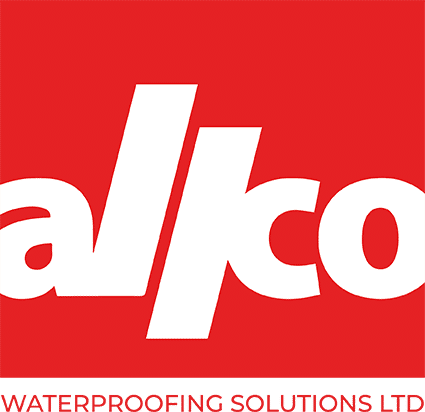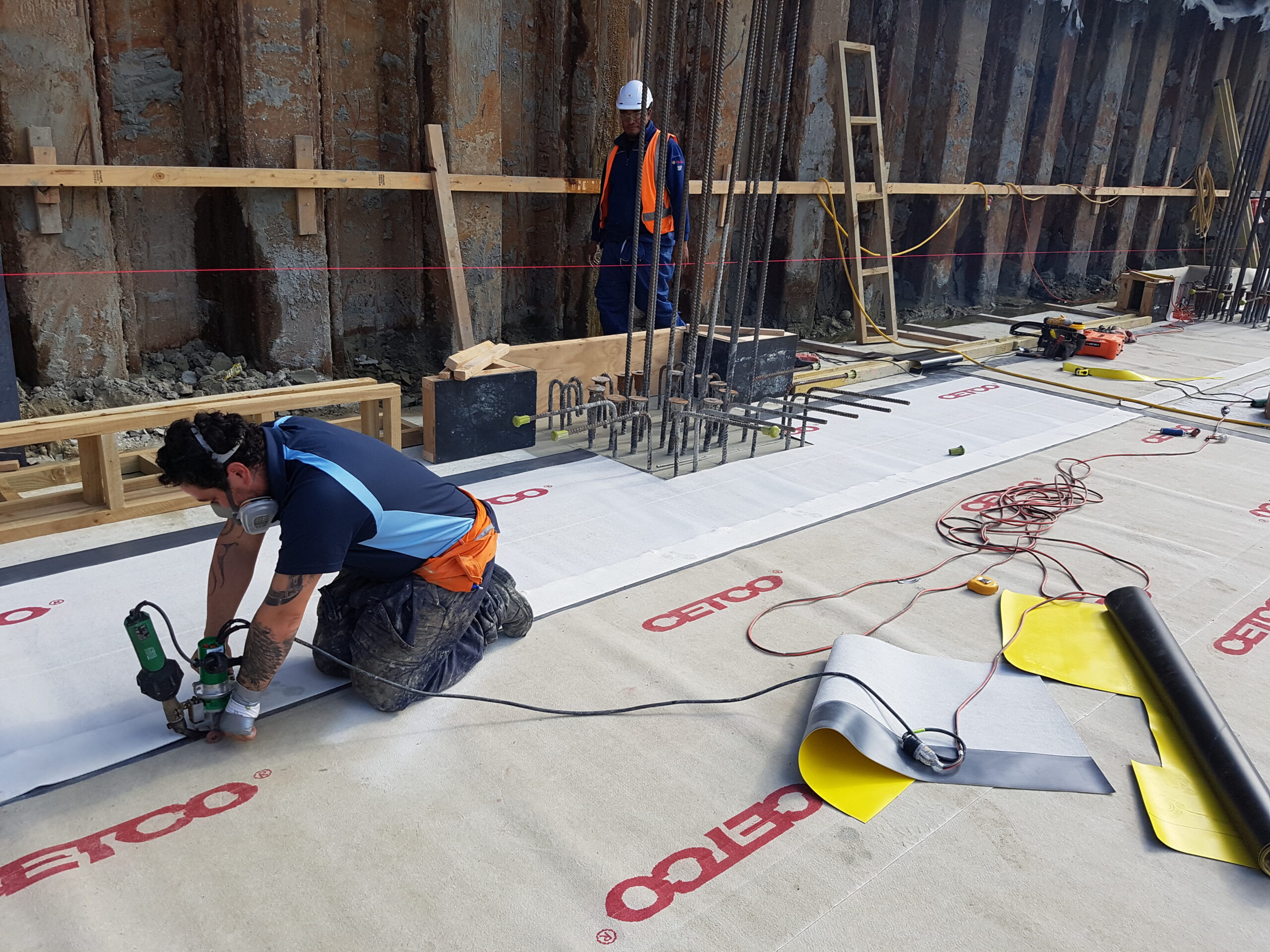CETCO Volclay – FAQ
We’ve put together some of the most commonly asked questions about our CETCO Volclay range and accessories.
If you have a question that you can’t find that you cant find below, please get in touch with our tech team: tech@allco.co.nz
• Voltex – Wet concrete substrates (precast panel forms incl)
• Swelltite – Post applied to concrete substrates (precast panels, masonry walls)
• Can be installed to uncured concrete.
• Weather conditions – installed in virtually any weather conditions
• Damage / Construction damage – self-healing for minor damage or patched easily placed.
• Contaminated ground – Voltex DS or Voltex SWR for saline soils.
• Head pressure – 20m (BRANZ) 60m (Swelltite – Cetco document)
• PLAZA / GREEN situation – Zero fall.
• Effect of Pressure – Needs pressure to function correctly – See KGA document.
Bentonite is the active ingredient in our Volclay (VOLcanic CLAY) range of waterproofing solutions including Voltex, Swelltite, Waterstop-RX.
Bentonite is essentially a high swelling clay mineral whose name was derived from the location of the first commercial deposits mined at Fort Benton, Wyoming U.S.A. This is the source of Volclay sodium bentonite
Yes. A special Volclay bentonite, Volclay DS/ SWR(Contaminate-Resistant), has been designed to work in soils with high concentrations of salts found in coastal regions. Volclay DS/ SWR is also resistant to other industrial chemicals that may be in the soils. A simple test of the groundwater from the construction site will produce results indicating whether standard Volclay or Volclay DS/ SWR is required for that specific project.
No. Volclay does not have to be fully hydrated upon installation. Like most other waterproofing membranes, Volclay will remain dormant until water comes in contact with the waterproofing. When water does contact Volclay, the Volclay immediately hydrates, forming a low permeable barrier.
Volclay waterproofing products use the natural mineral sodium bentonite. Then wetted, unconfined sodium bentonite can swell up to 15 times its dry volume. When confined, as in below-grade waterproofing applications, the Bentonite forms an impervious membrane and can seal cracks, punctures and small voids. After installation, Volclay waterproofing can self heal concrete cracks caused by shrinkage or seismic action. With the Volclay waterproofing system, the problem activates the solution, reliably and automatically.
No. Volclay, in most cases, does not require a working mud slab or site concrete to be installed over. The reason for this is that Volclay does not rely on adhesion to function as a waterproofing membrane. Remember, a mud slab traditionally is made of weak concrete mix and usually cracks. Therefore, you are not adhering the waterproofing to the structural slab, but waterproofing the mud slab, which is typically made of a weak concrete mix and is susceptible to cracking.
Yes. Volclay waterproofing systems are ideal for blind-side property line construction. Simply install Volclay to the retaining wall and pour the concrete in a single-sided form. Typical applications include soldier pile and wood lagging, metal sheet piling, earth and shotcrete retention walls, and concrete caisson construction.
For precast panels simply place the Volclay in the precast panel form at the precast yard or shoot Volclay onto the panels on site.
Volclay waterproofing systems can be installed to concrete as soon as the forms are removed. There is no seven to 28-day waiting period. Therefore, the work can be completed sooner, and the project can proceed on time.
Yes. Unlike most peel-in-stick and fluid-applied waterproofing membranes, Volclay can be installed when temperatures are below freezing. This allows work to proceed in the winter months on time, as scheduled.
Early during design development, the engineer or architect should determine whether the basement foundation will be within, or anticipated to be within, the water table or hydrostatic conditions. Most basements, even those perceived to be in dry areas, will be subjected to hydrostatic pressure, especially during when water cannot drain away fast enough or from blocked drains.
One metre of water on a wall is equivalent to one ton of force per square centimetre (making damp-proof membranes unsuitable). If a hydrostatic condition is present or anticipated, then a full enveloping system should be utilised in the structure.
Yes. Allco offers two warranty types: Product Warranty and System Warranty.
Product Warranty covers the quality and integrity of the product installed for 20 years and installation of the membrane is covered by the applicator. Our System Warranty is more comprehensive and includes both the product installed and the installation of the membrane as part of the 20 warranty cover. The warranty is issued directly to the owner of the project.
Yes. Waterstop RX is certified by NSF International to conform with the requirements of NSF Standard 61 for use with potable water concrete tanks with a minimum capacity of 3,785 litres (1,000 gallons).
Use Volclay SB-Primer or Cetseal to secure Waterstop RX in cold weather conditions. Volclay SB-Primer is specially formulated to work with Waterstop RX in freezing temperatures down to -7°C (20º F). Do not use other unapproved adhesives or nails to secure waterstop.
For Waterstop RX 101 and 101T, a minimum 75 mm (3”) of concrete coverage must be maintained from the edge of the product to the exterior face of the concrete. Waterstop RX 102 requires a minimum concrete coverage of only 50 mm (2”). The minimum concrete coverage must be maintained over the entire product installation.
No. Waterstop RX is designed for use in non-moving cast-in-place concrete joints. A properly engineered expansion joint product should be used to seal expansion joints.
Yes. Waterstop RX has worked successfully to seal concrete joints on projects where another manufacturer’s waterproofing membrane is used.
Yes. Waterstop RX is a great solution for sealing around pipes and other penetrations, where conventional passive PVC dumbbell waterstops cannot be installed. Simply secure Waterstop RX around the penetration with Volclay WB-Adhesive.
No. Waterstop RX should be adhered in place with Volclay Cetseal-Adhesive. The adhesive secures the entire length of the waterstop installation so that the product cannot shift or float during the concrete placement. If desired, nails can be used in conjunction with the adhesive application.
Yes. Waterstop RX is a great solution for sealing around pipes and other penetrations, where conventional passive PVC dumbbell waterstops cannot be installed. Simply secure Waterstop RX around the penetration with Volclay WB-Adhesive.
Yes, save time and money. Waterstop RX is a great solution for sealing the joint at new-to-existing concrete placement. Unlike conventional PVC waterstops, you do not need to saw cut or chip out part of the existing concrete to embed half the dumbbell. With Waterstop RX you simply secure the waterstop to the surface of the existing concrete with Volclay WB-Adhesive and pour the new concrete
Typically, Waterstop RX does not need to be replaced if the product is exposed to water for a short time period prior to concrete placement. If it rains, standing water should be removed as soon as possible and the product should not be left submerged in the water. As long as there is no notable expansion of the product, Waterstop RX would not need to be replaced.
Yes. Waterstop RX has worked successfully to seal concrete joints on projects where another manufacturer’s waterproofing membrane is used.
No. Waterstop RX should be adhered in place with Volclay Cetseal-Adhesive. The adhesive secures the entire length of the waterstop installation so that the product cannot shift or float during the concrete placement. If desired, nails can be used in conjunction with the adhesive application.
Unlike PVC dumbbell waterstops, Waterstop RX roll ends do not need to be hot air welded or glued. Simply abut the rolls ends tightly together to form a continuous waterstop.
Yes, save time and money. Waterstop RX is a great solution for sealing the joint at new-to-existing concrete placement. Unlike conventional PVC waterstops, you do not need to saw cut or chip out part of the existing concrete to embed half the dumbbell. With Waterstop RX you simply secure the waterstop to the surface of the existing concrete with Volclay WB-Adhesive and pour the new concrete
If you have any question about our products or if you require assistance with design, specification or compliance, please get in touch today with our team on (09) 448 1185 or email tech@allco.co.nz.


